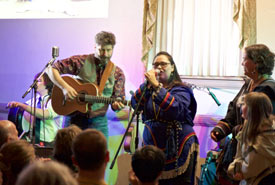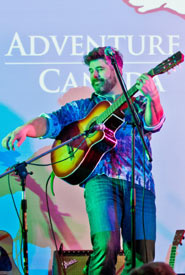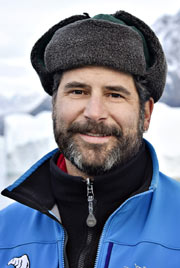Learning to listen to the land

The band in action with our throat-singing friends Lynda Brown and Heidi Langille (Photo by Dan Roy)
What does “tracing one warm line” mean to you? You may recognize the phrase from the classic Canadian folk song, Stan Rogers’ “Northwest Passage.” It describes a journey into a mythological northern homeland that we paradoxically never reach. But maybe it’s time we got there.
“Tracing one warm line” is what I do in the summers, as a Zodiac driver, host and performer aboard expedition cruises with Adventure Canada. Travelling on a small ship equipped with a fleet of Zodiacs, we ply the waters of the real-life Northwest Passage through Nunavut and along the coast of Greenland. In the company of Inuit culturalists, explorers, scientists, historians, archeologists, writers, artists and travellers, we experience first-hand the vast, ancient, rugged northern landscape.
Lately, in the off-season, I’ve been tracing one warm line in a more figurative sense — travelling Ontario with a band of musical friends, performing a show called The Northwest Passage in Story and Song. Our journey is along highways and byways, aided by Google Maps as we go. But we are also tracing our way through what Glenn Gould called, “the idea of North.”

David with the guitar (Photo by David Goodfellow)
Inspired by my own travels, the annals of Arctic exploration and the realities of contemporary life in Nunavut, I’m asking a (southern) audience what it means to be ”Northern” people while offering visual and emotional input that shifts the narrative. Most Canadians, in point of fact, live about as far from the Northwest Passage as they do from Central America. The Passage itself is a European idea (“Northwest” of England, a shortcut to Asia). It describes a route the Inuit, and their predecessors, had been travelling by dogsled, kayak and umiak for centuries before Europeans arrived in ships.
Stan Rogers sang of tracing one warm line “through a land so wide and savage.” By savage, he meant forbidding, dangerous and unconquered. Still, I find that lyric hard to hear today, knowing how “savage” has historically been used to describe and diminish First Peoples, including Inuit.
In the Euro-Canadian version of things, bold men go into empty places, bravely pitting themselves against the elements (and sometimes the people) in a land both “wide and savage.” In truth, the land has never been so wide as to be empty of human stories; never so savage as to be uninhabited. The terra incognita of British admiralty maps was the Inuit homeland.
As Canadians we are a self-styled “Northern” nation. Even inundated with media and popular culture from the south, we turn to the North for inspiration and identity. Stories like that of Sir John Franklin and his ill-fated Northwest Passage expedition thrill us. Perhaps it’s because they remind us how small we are in the face of nature. Still, these stories have been told by strangers, for whom the Arctic was a strange land. It’s time we heard other stories.

The band performing The Northwest Passage in Story and Song show (Photo by David Goodfellow)
What’s life like in an Arctic hamlet? How are cultural practices like drum dancing and throat-singing and tattooing reviving? What’s “country food?” What was the High Arctic Relocation? What happened to the sled dogs? What are the real issues of sovereignty? What’s the shipping infrastructure in the Arctic? What’s going on with polar bears? How many people actually live in the Arctic? What are challenges of community life? How are language, life-ways and family ties maintained today, as Inuit increasingly participate in the wider (southern) Canadian story?
Perhaps most importantly, how are we, as Canadians, bound by the Nunavut Land Claims agreement, which created the territory of Nunavut — Inuktitut for “Our Beautiful Land?”
As a southern Canadian, a recent visitor to the Arctic, I don’t have the answers. I have had the privilege of travelling, and witnessing, and I am passionate about asking the questions. Showing pictures, telling stories, singing songs — these are the ways we ask the audience at our shows to pay attention to what has been left off the map.
We don’t draw that one warm line; we trace it. That means to go over carefully what was already there. In the Arctic, and everywhere, it is the people of the land who carry the stories of the land. It is amazing what happens as we learn to listen.
Here is a clip of the song "Monument," with me and members of Uncharted Waters.


